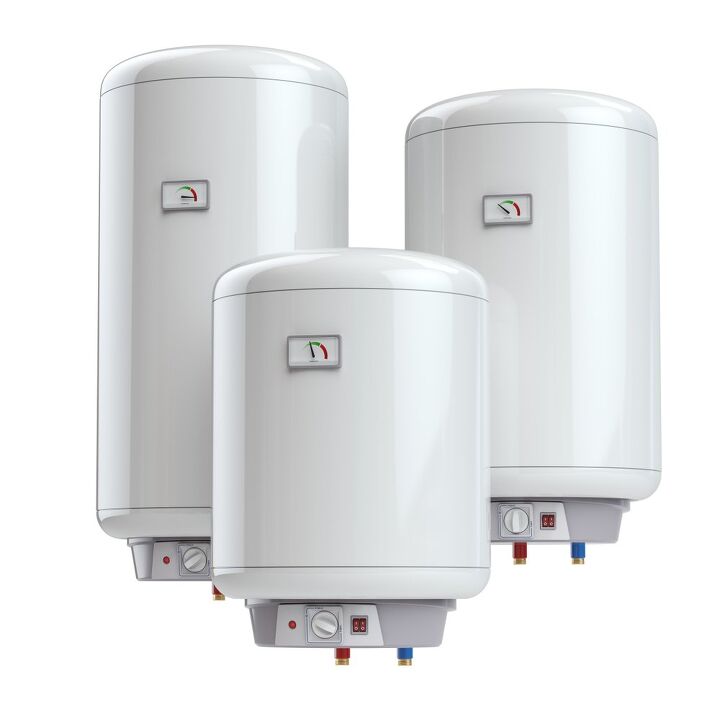Short Vs. Tall Water Heater: Which Is More Efficient?

Water heaters are a modern convenience and luxury that you can find in just about any home. At first glance, the only difference between short and tall water heaters is their height, but that isn’t entirely the case. So, besides the obvious height gap, what is the difference between short and tall water heaters?
Short water heaters are 39” tall on average, have a 23” diameter, and can hold up to 50 gallons of water. Tall water heaters can measure up to 60” tall, hold 100 gallons of water, and have a 40” pipe connection height. The 50-gallon capacity of short water heaters makes them more energy-efficient and cost-effective for small homes.
You can get by with a short water heater if you have multiple bathrooms, but tall water heaters are ideal for a 3 person family or more. Follow along as we explore the differences between short and tall water heaters.
Do You Need Water Heater Installation or Replacement?
Get free, zero-commitment quotes from pro contractors near you.

Short
Short water heaters measure an average of 39” tall, but they can stand as tall as 49”. The minimum height for a short water heater is 30”, and their diameter is never smaller below 20”. Short water tanks on the larger end of the spectrum can have a diameter as wide as 26”.
Homeowners benefit from short water heaters because you can install one in several areas of your home such as the garage or attic. You can even install a short water heater in a crawlspace, and that makes them more versatile than tall water heaters. Luckily, it is easy to install a short water heater, and the pipe connection height starts at 29”.
Professional installation is still ideal, but many builder-owners can install a small water heater with basic DIY knowledge. Small water heaters weigh an average of 120 pounds which is less than tall water heaters but too much to carry alone.
Tall
The average tall water heater measures 53” tall and you generally find them in homes with a basement. Tall water heaters can stand up to 60” tall and you must have the space to accommodate a 40” pipe connection height. It is more difficult to install a tall water heater than a short water heater because of its size, plumbing connection height, and weight.
Tall water heaters weigh an average of 153 pounds, and they rarely weigh less than 106 pounds. A tall water heater can weigh as much as 200 pounds, and that is why it is ideal to hire a professional to install it. You cannot install a tall water heater in as many spaces as a short water heater because of the large size and pipe connection requirements.
However, professionals and DIY-savvy homeowners can install a tall water heater with slanted pipes for an easier connection.
Differences
Aside from the obvious height difference, short and tall water heaters differ in several ways. Between the energy efficiency, capacity, and installation process, short and tall water heaters have plenty of differences. They may function largely the same way, but there are key differences that affect the cost and convenience of the water heater. Let’s take a look at the main differences between short and tall waters
Efficiency
Even though they work similarly, short water heaters are much more energy-efficient than tall water heaters. Small water heaters are up to 40% more energy-efficient than tall water heaters and can save on bills. The increased energy-efficient of short water heaters has to do with the water capacity and power consumption.
With that said, the larger water capacity of tall water heaters is arguably more efficient than a short water heater. The efficiency of a water heater ultimately comes down to your usage and what size best accommodates your home. Small homes or homes with few residents generally only need a short water heater, and it can potentially lower your water and power bills.
Capacity
Tall water heaters have a larger water capacity than small water heaters because they are taller and have a wider diameter. You can store up to 100 gallons of water in a tall water heater or more, and small water heaters can only hold 50 gallons on average. Water capacity varies based on the size of the water heater, but tall models can hold over twice
Family homes can benefit from tall water heaters because they can easily keep up with multiple residents’ water usage. The water demands for a tall water heater are expensive and inefficient, but it is ideal if you have a large home or family.
Installation
The installation process for short and tall water heaters is largely similar, but it varies in several key ways. For example, you are limited to where you can install tall water heaters because of the plumbing connection and special requirements. Large water heaters can only fit in open spaces with plenty of room, and they are ideal for a garage or basement.
You also need to install a tall water heater in a spot with an average 40” pipe connection. That limits where you can comfortably install a tall water heater. However, you can use extended or angled pipes to reach a tall water heater if it comes to that, but it may not look pretty.
However, it is easy to connect pipes to a short water heater whether it is on a stand or not. Short water heaters are still heavy and it is best to install one with at least one other person. Professional installation is ideal for both tall and short water heaters, but short water heaters are more manageable for DIYers.
Similarities
Short and tall water heaters are similar for the most part, and their main differences come from the capacity. Beyond capacity, short and tall water heaters function the same way and are available in the same variety. You need to install both short and tall water heaters in an area with access to the plumbing system.
You can install a short or tall water heater with the same tools and steps despite the difference in weight, difficulty, and connection height. A water heater can heater at the same rate whether it is short or tall. Height is a major factor in water heaters when it comes to efficiency and capacity, but short and tall water heaters are the same otherwise.
Is a Tall or Short Water Heater Better?
Tall and short water heaters are similar in function, but tall models are better for big houses and families. They have a large water capacity that is enough to support multiple showers and plumbing fixtures. You generally need a tall water heater if 3 or more people live in your home to accommodate the hot water needs.
The main advantage of short water heaters is that they generally hold 50 gallons of water and use less energy than tall water heaters. Tall water heaters have to work harder to heat the water because of the larger capacity. That means that you’ll spend more money on the water and the energy that it takes to heat it with tall water heaters.
Short water heaters are better if you have a smaller home with limited plumbing fixtures, and tall heaters are ideal for families. Tall and short water heaters are both effective and function the same way aside from their capacity.
Related Questions
Are smaller water heaters more efficient?
Small water heaters are up to 40% more energy-efficient than tall water heaters because of the water capacity. A larger water heater can generally hold 40%-50% more water than small water heaters, and that is more wasteful. It also takes more energy to heat up to 100 gallons of water in a large than it does to heat 40-50 gallons for a small water heater.
How tall does a water heater stand need to be?
You must have an 18” stand for your water heater if it is gas-powered. The stand can help to reduce the risk of fires by elevating the heating element. You don’t need to put an electric water heater on a stand because there is no fuel source that can ignite or catch fire.
Related Guides

We are a team of passionate homeowners, home improvement pros, and DIY enthusiasts who enjoy sharing home improvement, housekeeping, decorating, and more with other homeowners! Whether you're looking for a step-by-step guide on fixing an appliance or the cost of installing a fence, we've here to help.
More by Upgraded Home Team














![10 Best Electric Lawn Mowers - [2022 Reviews & Top Rated Models]](https://cdn-fastly.upgradedhome.com/media/2023/07/31/9070486/10-best-electric-lawn-mowers-2022-reviews-top-rated-models.jpg?size=350x220)












